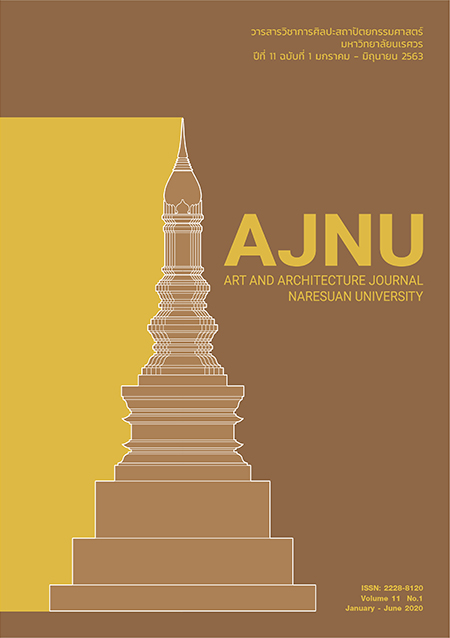Development of an interactive picture book
Main Article Content
Abstract
The purposes of this development of the interactive picture book were (1) to create model of an interactive picture book, (2) to develop an interactive picture book, (3) to evaluate the quality of this interactive picture book, and (4) to evaluate the satisfaction from upper secondary school students towards this interactive picture book. The sample population was 360 upper secondary school students in the Muang district of Maha Sarakham province whom were randomly drawn using the simple random sampling technique. The research instruments used were (1) the model of an interactive picture book, (2) the interactive picture book, (3) the design evaluation form, (4) the quality evaluation form, and (5) the satisfaction evaluation form. The statistics used in the data analysis were frequency, percentage, mean ( ), and standard deviation (S.D.)
The study results showed that the model of an interactive picture book contains 4 elements: users, the picture book, reading, and interaction. Also, the interaction between users and the picture book has 4 steps. First, the smartphone or tablet application connects to the internet. Then, users scan a picture from the picture book using the Aurasma application. Next, the application processes the picture into a cartoon animation or a video clip. Finally, the application displays the said clip. Overall, the result of the design of the picture book has 6 components, which was appropriate and it can be adapted for use by the sample population. The quality evaluation was done on the following 8 aspects of the interactive picture book: make of the book, organization of accompanied pictures, presentation, language and alphabet, cover book, content, cartoon animation/video clip, and interaction and book usage. With these quality aspects, the quality of book was evaluated at the very-high level. The sample upper secondary school students expressed their satisfaction with the interactive picture book at the highest level.
Article Details
References
กล่อมจิตต์ พลายเวช. (2549). วรรณกรรมสำหรับเด็กปฐมวัย. เอกสารการสอนชุดวิชาวรรณกรรม และลึลาคติระดับปฐมวัยศึกษา. พิมพ์ครังที่ 7. นนทบุรี : มหาวิทยาลัยสุโขทัยธรรมาธิราช.
กัณฑรี วรอาจ และไพฑูรย์ ศรีฟ้า. (2556). การพัฒนาหนังสืออ่านเพิ่มเติมที่มีความจริงเสมือน เรื่องประเทศสิงคโปร์ ผ่านไอแพด สำหรับนักเรียนชั้นมัธยมศึกษาปีที่ 1. วารสารวิชาการศรีปทุม ชลบุรี. 101-109.
ณรงค์ ทองปาน. (2526). การสร้างหนังสือสำหรับเด็ก. กรุงเทพฯ : กรมฝึกหัดครู.
ณัฐมา ไชยวรโยธิน. (2556). การพัฒนาหนังสืออิเล็กทรอนิกส์ เรื่องศิลปะการแสดงประจาชาติประเทศในประชาคมอาเซียนด้วยเทคโนโลยีออรัสม่า. วารสารวิจัยออนไลน์นวัตกรรมการศึกษา : e-Journal of Innovative Education". 2(1), (พฤษภาคม-ตุลาคม), 158-165.
นงคราญ ศรีสะอาดและคณะ. (2557). การสร้างสภาพแวดล้อมทางการเรียนจากเทคโนโลยีเสมือนจริง โดยใช้ กระบวนการสืบเสาะหาความรู้ เพื่อพัฒนาทักษะกระบวนการทางวิทยาศาสตร์ เรื่องระบบสุริยะ สำหรับนักเรียนชั้นประถมศึกษาปีที่ 4. รายงานสืบเนื่องจาการประชุมสัมมนาทางวิชาการ มหาวิทยาลัยเทคโนโลยีราชมงคลตะวันออก ครั้งที่ 7. 7(1), 13
นิติศักดิ์ เจริญรูป. (2560). การประยุกต์ใช้ความเป็นจริงเสริมเพื่อนำเสนอข้อมูลแหล่งท่องเที่ยว : กรณีศึกษาวัดพระแก้ว จังหวัดเชียงราย. วารสารวิทยาการจัดการสมัยใหม่. 10(1), (มกราคม – มิถุนายน), 13-30.
เนารุ่ง วิชาราช. (2558). การพัฒนาสื่ออิเล็กทรอนิกส์ เรื่องประชาคมอาเซียนด้วยเทคโนโลยีออรัสมา. รายงานสืบเนื่องจากการประชุมสัมมนาวิ่ชาการนำเสนิงานวิจัยระดับชาติ (Proceedings) เครือข่ายบัณฑิตศึกษา มหาวิทยาลัยราชภัฎภาคเหนือ ครั้งที่ 15. 615-322.
พูนศรี คัมภีรปกรณ์. (2549). การเลือกและการใช้หนังสือสำหรับเด็กปฐมวัย. เอกสารการสอนชุดวิชา วรรณกรรมและสิลาคติระดับปฐมวัยศึกษา. พิมพ์ครั้งที่ 7. นนทบุรี : มหาวิทยาลัยสุโขทัยธรรมาธิราช.
ไพฑูรย์ ศรีฟ้า. (2556). ผูกข้อมูลไว้ในโลกเสมือนจริงด้วยเทคโนโลยี Aurasma. CAT Magazine. 32 (พฤษภาคม–มิถุนายน), 40-41.
วิมลิน มีศิริ. (2551). โครงสร้างการเล่าเรื่องกับการสื่อสารความหมายสำหรับเด็ก. วิทยานิพนธ์หลักสูตรวารสารศาสตรมหบัณฑิต สาขาวิชาสื่อสารมวลชน มหาวิทยาลัยธรรมศาสตร์.
ศุษมา แสนปากดี. (2557). การประยุกต์ใช้เทคโนโลยีเสมือนจริงในบอร์ดประชาสัมพันธ์ประชาคม เศรษฐกิจอาเซียน. การประชุมวิชาการมหาสารคามวิจัยครั้งที่ 10. วารสารวิทยาศาสตร์ละเทคโนโลยี. 257-264.
สนั่น สระแก้ว ปรัชญา เฉลิมวัฒน์ และอภิชญ์ บุศยศิริ. (2554). แอนิเมชันสารานุกรมไทยสำหรับเยาวชนฯ เล่มที่ 36. สืบค้นข้อมูล 22 ตุลาคม 2560,จาก http://kanchanapisek.or.th/kp6/sub/book/book.php?book=36&chap=7&page=chap7.htm
สมศักดิ์ เตชะโกสิตและ พัลลภ พิริยะสุรวงศ์. (2558). การเรียนการสอนตามทฤษฎีการเรียนรู้เพื่อสร้างสรรค์ด้วยปัญญาโดยใช้เทคโนโลยีเสมือนจริงในวิชาวิทยาศาสตร์. วารสารวิชาการครุศาสตร์อุตสาหกรรม พระจอมเกล้าพระนครเหนือ. 6(1), (มกราคม - มิถุนายน), 225-230.
Glazer, J. I. (2000). Literature for young children (4th ed.). New Jersey: Prentice-Hall.


